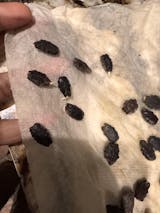
Buag Ngu Snake Gourd
$4.95
100%
Non-GMO
Free
Shipping
Service
Guaranteed
Also Known As: Snake Melon, Snake Squash, Snake Cucumber, Chichinda, Padwal, Pudalangai, Serpent Gourd, Chinese Cucumber, Turiya, Padavalanga, Pathakaya, Pakupis, Snake Tomato, Baup Ngu, Pudalankaai, Paduvalakaayi.
| Plant Name: | Snake Gourd, Buag Ngu |
| Latin Name: | Trichosanthes cucumerina |
| Days to Germinate: | 7-14 |
| Days to Harvest: | 120 |
| Plant Height: | 14 -18 Feet |
| Spread: | 5 - 9 Feet |
| Growth Habit: | Vining |
| USDA Zones: | 3-12 |
| Lifespan: | Annual, Perennial 9-12 |
| Brand: | TomorrowSeeds |
| Sunlight: | Full Sun, Partial Shade |
| Pollination: | Heirloom, Open-Pollinated |
| GMO: | No |
| Fungicide-Treated Seeds*: | No |
| Seeds Packed For**: | 2025 |
**Seeds are freshly packed for the growing season of the year listed. Seeds are still viable beyond pack date. Store in a cool and dry location such as the refrigerator or basement to best preserve germination rates.
Planting Instructions:
Soil Preparation:
Choose an area with heavy, well-draining soil that receives at least 6 hours of sunlight each day. Remove weeds, large rocks, and litter from the planting area. Leave small weeds and dead grass, they will enrich the soil when turned under. Spade or till the soil 8-12 inches deep. Loosening the soil will help the plant establish strong roots.
Plants grow best in soil with lots of organic matter. You may optionally add fertilizer or organic material such as compost, leaves, or rotted hay to mix into the soil at this point. For small gardens, scatter 2-3 tablespoons of fertilizer evenly and work into the top 2-3 inches of soil for each hill or 2 foot by 2 foot planting area. For larger gardens, scatter 2-3 pounds of a complete fertilizer for each 100 square feet of planting area. Work fertilizer or organic material into the soil and leave the surface smooth.
Form rows of soil beds 4-6 inches high and at least 3 feet apart. This formation of ridges will help with drainage.
Planting:
Gourds grows best in warm weather.Starting Indoors: For an earlier harvest, you may optionally start planting indoors in containers 3-4 weeks before the last expected frost date in Spring, keeping seedlings at least 70F. Harden off then transplant seedlings outdoors in a sunny location when the soil temperature is above 65F. To transplant seedlings, prepare a transplant hole outdoors in a sunny location. Remove the plants carefully from the pots or flats and set them in the holes, burying some of the stem in the ground. Pack the soil loosely around the plant and leave a slightly sunken area around each plant to hold water. Water the plants after transplanting. Train plants to climb a 6-8 foot trellis or fence as they establish. This maximizes yield, ensures plants are well-watered and allows the gourds to grow straight and easy to pick.
Directly Sowing: If directly sowing gourds outdoors, plant in mid-late spring when the soil warms to at least 70F. Fall planting is not typically recommended but is possible in climates with mild winters (USDA Zones 9-11), or if growing indoors >70F and using supplemental grow lights.
To plant, make holes 1 inch deep and spaced 4 feet apart down the rows of raised beds. Plant 2-3 seeds per hole. If choosing to thin to the strongest plant, determine the strongest and healthiest plant, then remove all other plants, narrowing to a single plant per hole. Cover seeds thinly with soil and water after planting. Train plants to climb a 6-8 foot trellis or fence as they establish. This maximizes yield, ensures plants are well-watered and allows the gourds to grow straight and easy to pick.
| Planting Depth: | 1 inch |
| Within-Row Spacing: | 4 feet |
Care During the Season:
Watering: Water the plants deeply, soaking the soil to a depth of 6-8 inches, once to twice a week. If there is no rainfall, water 3-4 times a week. Sandy soils may need to be watered more often than heavy clay soils. Mulching around plants can help retain moisture.
Weeding: Keeping plants weed-free improves production. If plowing or hoeing, do not dig deeper than 1 inch to prevent from cutting the feeder roots.
Fertilizing: Once seedlings are established, 2-3 weeks after germination, you may optionally apply 2 tablespoons of a complete fertilizer around each hole, or 1-2 pounds per 100 square feet, without letting the fertilizer touch the plants. Optionally, continue fertilizing every 3-4 weeks as plants grow, especially after flowering begins. Water plants after fertilizing.
Insecticides: Insecticides may be used to protect plants. Bt-based insecticides and sulfur are organic options that can be used for prevention. Sulfur also has fungicidal properties and helps in controlling many diseases. Before using a pesticide, read the label and follow cautions, warnings and directions.
Diseases: If spots or mold appear, treat plants with an approved fungicide. Neem oil, sulfur, and other fungicides may be used. When using fungicides always follow label directions.
Harvesting:
Stem mustard tuber, also known as mustard stem or tuberous mustard (), is best harvested when the swollen stems reach about 4 to 6 inches in diameter, typically 60 to 80 days after planting. For the best texture and flavor, harvest before the stems become too tough or fibrous. To harvest, use a sharp knife or garden shears to cut the stem at the base, leaving the roots behind. The ideal time to harvest is early in the morning when the plant is well-hydrated and crisp. After harvesting, the tuber can be cleaned and either eaten fresh, pickled, or used in stir-fries. If multiple plants are grown, staggered harvesting allows for an extended yield. For continued production, ensure the plants receive consistent watering and nutrient-rich soil, as healthy growth contributes to plump, flavorful stems.
















